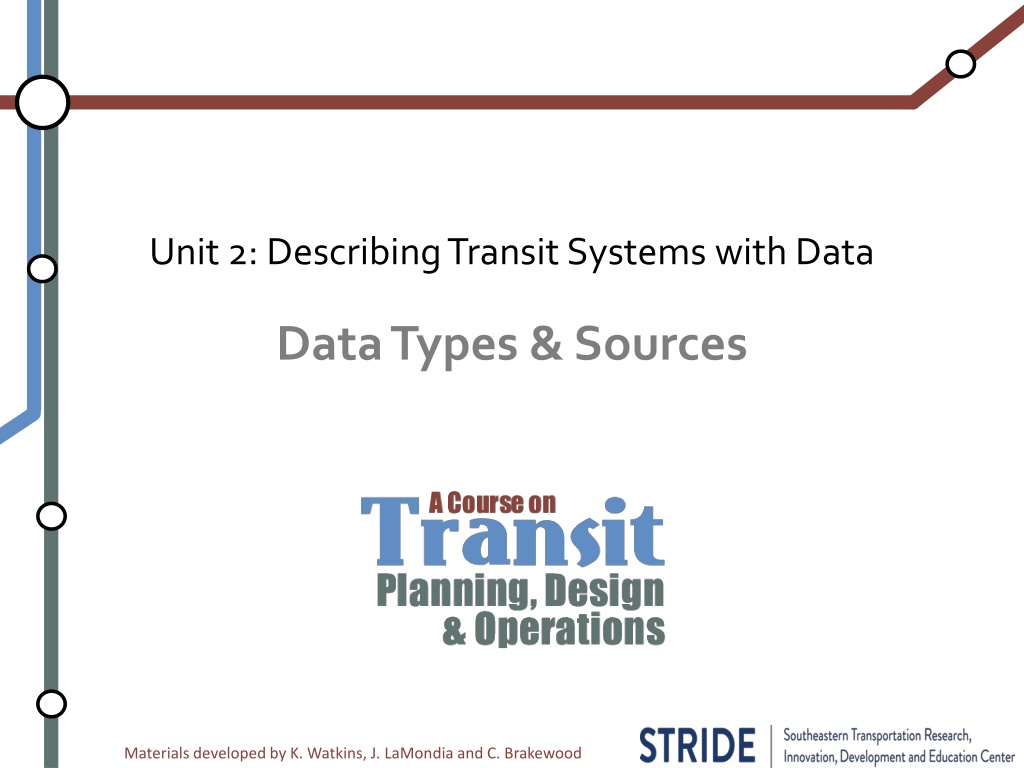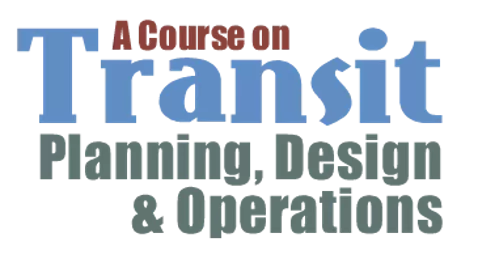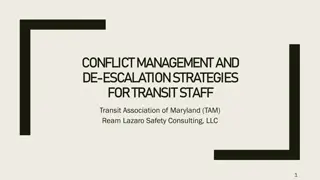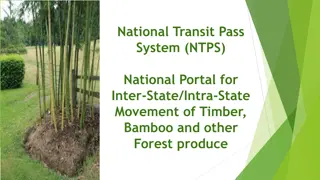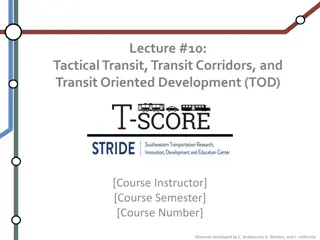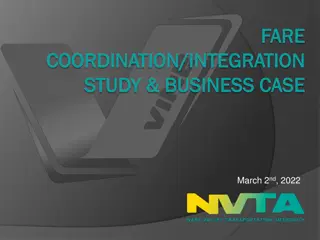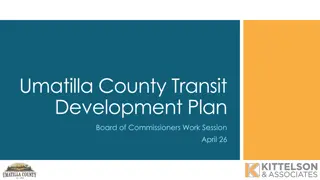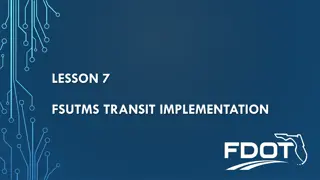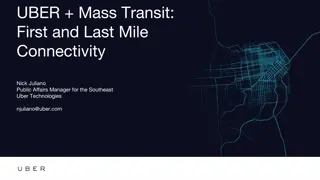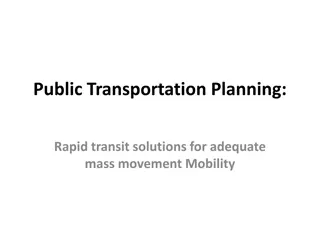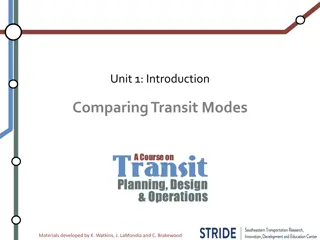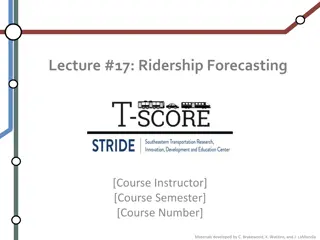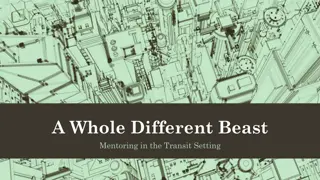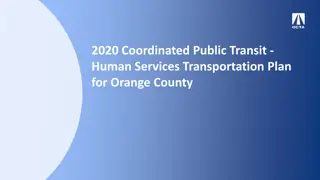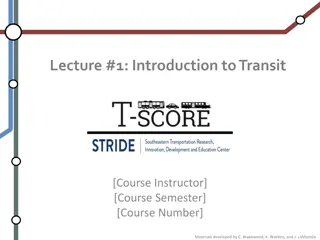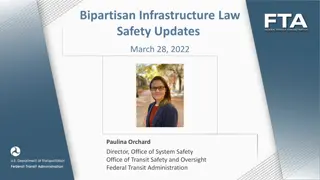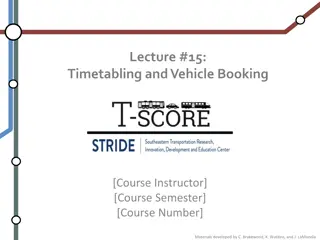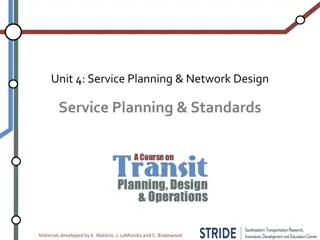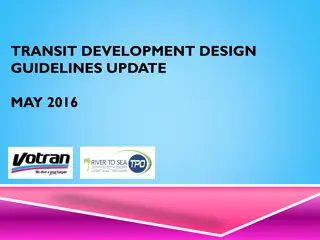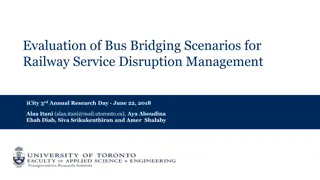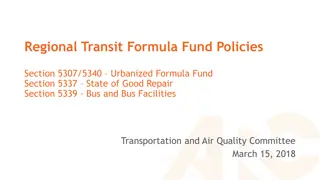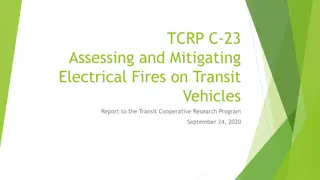Exploring Transit Data for Service Improvement
Dive into the world of transit data, where understanding different types such as system-level, route-level, and trip-level data can help in optimizing service quality. Discover the importance of accurate data in making informed decisions for transit systems, from service planning to operational control. Developed by K. Watkins, J. LaMondia, and C. Brakewood.
Download Presentation

Please find below an Image/Link to download the presentation.
The content on the website is provided AS IS for your information and personal use only. It may not be sold, licensed, or shared on other websites without obtaining consent from the author.If you encounter any issues during the download, it is possible that the publisher has removed the file from their server.
You are allowed to download the files provided on this website for personal or commercial use, subject to the condition that they are used lawfully. All files are the property of their respective owners.
The content on the website is provided AS IS for your information and personal use only. It may not be sold, licensed, or shared on other websites without obtaining consent from the author.
E N D
Presentation Transcript
Unit 2: Describing Transit Systems with Data Data Types & Sources Materials developed by K. Watkins, J. LaMondia and C. Brakewood
Outline Types of transit data Manual data collection Automated data collection Materials developed by K. Watkins, J. LaMondia and C. Brakewood
We need to quantify and characterize our systems with different TYPES OF TRANSIT DATA Materials developed by K. Watkins, J. LaMondia and C. Brakewood
Service Is Only As Good As Your Data We need accurate data to make appropriate decisions for transit service. What if we were considering adding a new line to a transit system? What information would we need to know to make appropriate design decisions? Materials developed by K. Watkins, J. LaMondia and C. Brakewood
What Data is Needed to Maintain Good Service? 7 Demands of Useful Service It gives me freedom (to change my plans). It takes me where I want to go. It takes me when I want to go. It is a good use of my time. It is a good use of my money. It I can trust it. respects me. Stops/ Stations Speed or Delay Frequency Span Fares Civility Reliability Simplicity /Presentation Connectivity How Transit Services Them Materials developed by K. Watkins, J. LaMondia and C. Brakewood
Three Main Types of Data System Level Data Entire operational overview Useful for long-range planning, comparing service to similar regions Route Level Data Characteristics of specific routes Useful for long-range planning, service planning, route optimization Trip Level Data Specific details of trips made on transit system Useful for service planning, route optimization Materials developed by K. Watkins, J. LaMondia and C. Brakewood
Service Quality Improvement Cycles Service Plan Analyze Performance and Demand Operational Control & Passenger Info Transit Operation Archive Data Real- time loop Automated Data Gathering Off-line loop Materials developed by K. Watkins, J. LaMondia and C. Brakewood
System Level: National Transit Database (NTD) Established by Congress (Title 49 USC 5335a) Primary source for statistics on transit in US FTA grantees required to submit data >660 providers currently report to NTD Data used to apportion > $5 billion FTA funds Freely and publically available Materials developed by K. Watkins, J. LaMondia and C. Brakewood
2011 National Transit Profile Does this look familiar? Materials developed by K. Watkins, J. LaMondia and C. Brakewood
What is in the NTD? Modules include: Safety and Security Financials Capital funds, operating expenses, operator wages Assets Stations and maintenance facilities, transit way mileage, revenue vehicles Resources Number of employees, energy consumption Transit Service (Supplied and Consumed) Vehicle revenue miles, Vehicle revenue hours, unlinked passenger trips, passenger miles traveled Materials developed by K. Watkins, J. LaMondia and C. Brakewood
NTD Glossary (Expenses) Capital Expenses = purchase of equipment Useful life > one year and Greater than $5,000 Includes Facilities (Guideway, Passenger Stations, Administration Buildings, Maintenance), Rolling Stock (vehicles), Other Equipment Operating Expenses = operation of the agency Function (Vehicle Operations, Vehicle Maintenance, Non- Vehicle Maintenance, General Administration) Object Class (Salary&Wages+Fringe= Compensation, Services , Materials and Supplies, Utilities, Casualty and Liability, Purchased Transportation, Other) Materials developed by K. Watkins, J. LaMondia and C. Brakewood
NTD Glossary (Service Consumed) Unlinked Passenger Trips = boardings Passenger Miles = cumulative sum of the distances ridden by each passenger Average Trip Length = avg distance ridden for = passenger miles / unlinked passenger trips Average Passenger Load = avg # pass aboard a vehicle at any one time Materials developed by K. Watkins, J. LaMondia and C. Brakewood
NTD Glossary (Service Supplied) Average Speed = miles / hours in revenue service Revenue Service = operation when passengers can board and ride on the vehicle Vehicle Total Miles = all miles from pull out to pull in, including "deadhead" Vehicle Revenue Miles = miles in revenue service Vehicle Total Hours = hours from pull out to pull in, including "deadhead" Vehicle Revenue Hours = hours in revenue service Materials developed by K. Watkins, J. LaMondia and C. Brakewood
NTD Glossary (Service Supplied) Revenue Vehicle = vehicle in fleet available to operate in revenue service including spares and out for maintenance Vehicles Available for Maximum Service = vehicles agency has available to operate revenue Vehicles Operated Maximum Service = largest # vehicles operated at any one time Base Period Requirement = vehicles needed to serve the base (all- day) transit service Peak-to-Base Ratio = Max Service / Base Period Percent Spares = (Veh Available Veh Operated) / Veh Operated Materials developed by K. Watkins, J. LaMondia and C. Brakewood
NTD Performance Measures Service Efficiency Operating Expense per Vehicle Revenue Mile Operating Expense per Vehicle Revenue Hour Service Effectiveness Operating Expense per Passenger Mile Operating Expense per Unlinked Passenger Trip Service Effectiveness Unlinked Passenger Trips per Vehicle Revenue Mile Unlinked Passenger Trips per Vehicle Revenue Hour Materials developed by K. Watkins, J. LaMondia and C. Brakewood
Head to www.ntdprogram.gov to complete the IN-CLASS EXERCISE Materials developed by K. Watkins, J. LaMondia and C. Brakewood
Route and Trip Levels Are Similar We describe unlinked passenger trips with Route Stop Locations Route Scheduling & Efficiency Volumes of Passengers Access/ Egress Locations Travel and Boarding Times Trip Purposes Exact Characteristics Depend on Application Two ways to collect this detailed data Manually Automatically Materials developed by K. Watkins, J. LaMondia and C. Brakewood
Engineers can tailor route and trip analyses through MANUAL DATA COLLECTION Materials developed by K. Watkins, J. LaMondia and C. Brakewood
Manual Procedure Considerations Instruments: Pencil/paper Hand-held units Route Selection: 100 percent Sample Type of Checks : Ride check: on-board the vehicle Point checks: at a specific location Surveys also used (at trip-level) Materials developed by K. Watkins, J. LaMondia and C. Brakewood
Ride Checks Captures an entire route in detail Data collection is done on-board Checkers counts the number of boardings, alightings, & thru-passengers at each stop Distance between each stop may also be recorded Output: Route-level & Stop-level ridership data Materials developed by K. Watkins, J. LaMondia and C. Brakewood
Ride Check Data Sheet - Example Materials developed by K. Watkins, J. LaMondia and C. Brakewood
Ride Check - Basic Calculations 1. Total Unlinked Passenger Trips on the Route = Sum of all Boardings 2. Load Profile for the Route = Cumulative Boardings @ Stop Cumulative Alightings @ Stop Peak (maximum) load along the route Average load along the route 3. Passenger Miles Traveled on the Route = Sum of Stop-Level Load * Distance between Stops Materials developed by K. Watkins, J. LaMondia and C. Brakewood
Example Load Profile Bus Route Load Profile 50 Peak Load Point: 47 Pax 45 40 35 30 Passenger Load Average Load: 24 Pax Load per Stop 25 Average Load 20 15 10 5 0 Stop #1 Stop #10 Stop #20 Stop #30 Materials developed by K. Watkins, J. LaMondia and C. Brakewood
Point Checks Data collection is done at one (or more) stops along a route Number of passengers on the vehicle is recorded Often conducted at high (peak) load points along a route Materials developed by K. Watkins, J. LaMondia and C. Brakewood
Surveys Travel surveys are used to estimate complete origin-destination patterns Questions include boarding location, alighting location, transfer location More next lecture Materials developed by K. Watkins, J. LaMondia and C. Brakewood
Transit operators are increasingly relying on new technologies AUTOMATED DATA COLLECTION Materials developed by K. Watkins, J. LaMondia and C. Brakewood
Automated Data Sources 1. Automated Fare Collection (AFC) 2. Automated Passenger Counters (APC) 3. Automated Vehicle Location (AVL) Archived data from AFC and AVL systems is an important byproduct of installing these systems. Materials developed by K. Watkins, J. LaMondia and C. Brakewood
Automated Fare Collection (AFC) Magnetic stripe & smart cards Smart card systems have unique ID that provides entry (exit) information at the individual level Data not available in real-time (coming soon!) Magnetic stripe and smart cards together can produce station/stop level data Rail gateline counts Bus fare boxes (operator often punches a key indicating other fare types, such as free passes) Materials developed by K. Watkins, J. LaMondia and C. Brakewood
Smart Card Example: OD Estimation AM Inbound trip: tap-in at origin PM Outbound trip: tap-in at destination Infer that passenger is traveling from Brookhaven to Midtown and back AM Tap at Brookhaven PM Tap at Midtown Materials developed by K. Watkins, J. LaMondia and C. Brakewood
Automated Passenger Counters (APC) Sensors near vehicle doors count passenger on and offs, usually using infrared beams Some vehicles also determine weight/steps on-board vehicle Typically data not available in real-time Usually only on a sample (%) of bus fleet; redistribute buses to determine counts Materials developed by K. Watkins, J. LaMondia and C. Brakewood
Automated Vehicle Location (AVL) Originally, Signpost-beacon-based used to track the location of buses Post-2000, GPS-based technology Provided in real-time Usually matched with schedule through Computer Aided Dispatch (CAD) systems Also combined with other data sources (AFC & APC) to capture detailed ridership Valuable for service planning (i.e. determining running times, schedule adherence) Materials developed by K. Watkins, J. LaMondia and C. Brakewood
Signpost-based AVL Materials developed by K. Watkins, J. LaMondia and C. Brakewood
GPS-based AVL Materials developed by K. Watkins, J. LaMondia and C. Brakewood
Combining AVL & APC Detailed Route Level Analysis Materials developed by K. Watkins, J. LaMondia and C. Brakewood
DATA COLLECTION COMPARISON Materials developed by K. Watkins, J. LaMondia and C. Brakewood
Manual vs. Automated Data Manual Data Low capital costs High marginal (labor) costs Small sample sizes Limited spatial and temporal variation Often unreliable (errors by checkers) Longer data collection/processing times Automated Data High capital costs Low marginal (labor) costs Large sample sizes Detailed temporal and spatial data Biases can (usually) be corrected Available in (quasi) real-time Materials developed by K. Watkins, J. LaMondia and C. Brakewood
Passenger Counting Technologies (2008) Technology / Procedure # Systems Percentage Combination of manual and automatic 44 51.2% Manual (paper and pencil) only 18 20.9% APCs only 12 14.0% Other automated methods (farebox, hand-held units) 12 14.0% Total systems 33 100.0% Materials developed by K. Watkins, J. LaMondia and C. Brakewood
Future Trends Increasing use of automated data collection systems Including mixed modes (manual & automated) More disaggregate data used for planning and decision-making (refined units of analysis) Materials developed by K. Watkins, J. LaMondia and C. Brakewood
DATA STANDARDS Materials developed by K. Watkins, J. LaMondia and C. Brakewood
Transit Data Consumption The changing landscape Digitization Paper Schedules Interactivity Schedule 10 9:36 Materials developed by K. Watkins, J. LaMondia and C. Brakewood
General Transit Feed Specification shapes.txt routes.txt trips.txt agency.txt GTFS stops.txt calendar.txt stop_times.txt Materials developed by K. Watkins, J. LaMondia and C. Brakewood
How Does Open Data Help? Data access models Transit Agency Agency produces data and opens it once. DATA Agency responds to special requests by developers DATA Anyone can access data App Developers Small subset of riders find this specific tool useful. Riders Many riders access a diverse market of tools powered by GTFS. Materials developed by K. Watkins, J. LaMondia and C. Brakewood
Transit Open Data Timeline Source: Rojas, Francisca (2012) Transit Transparency: Effective Disclosure through Open Data Materials developed by K. Watkins, J. LaMondia and C. Brakewood
Open Schedule Data (GTFS) Adoption Source: Wong, James. (2013). Leveraging the General Transit Feed Specification (GTFS) for Efficient Transit Analysis. Proceedings of the 2013 Transportation Research Board Annual Meeting. 44 Materials developed by K. Watkins, J. LaMondia and C. Brakewood
Conclusions We need accurate data to make appropriate decisions for transit service. The National Transit Database (NTD) is the largest source of transit data in the US. Manual data collection consists in recording transit information in person. Automatic data collection uses captors in buses to record vehicle location, vehicle loads, etc. Future trend of opening up data based on standardized formats. Materials developed by K. Watkins, J. LaMondia and C. Brakewood
Reference Materials in this lecture were taken from: Walker, J. (2011). Human transit: How clearer thinking about public transit can enrich our communities and our lives. Island Press. Furth, Hemily, Muller, Strathman (2006). Using Archived AVL-APC Data to Improve Transit Performance and Management. TCRP Report 113." Transportation Research Board. National Transit Database Sampling Manual (2009) "Sampling Tests Automatic Passenger Counters." The Inside Lane. 26 Sept. 2011. Boyle, D (2008). "TCRP Synthesis 77: Passenger Counting Systems. TRB, National Research Council, Washington, D. C. Materials developed by K. Watkins, J. LaMondia and C. Brakewood
